Blackout and Laser Safety Materials
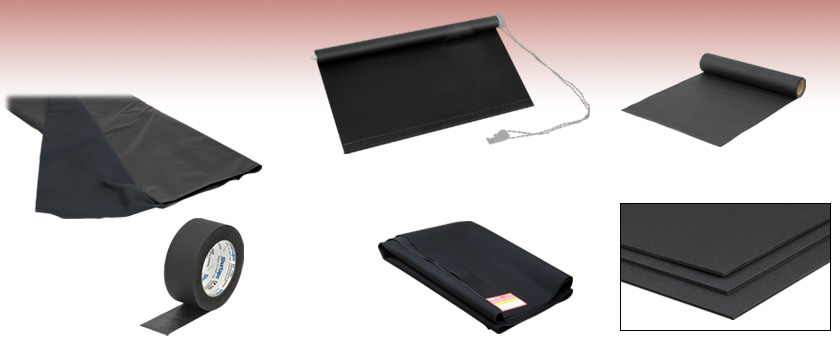
- Block Stray or Unwanted Light
- Build Light-Tight Structures
- Protect Light-Sensitive Equipment
BK5
Blackout, Nylon Fabric with
Polyurethane Coating
LPCM1
Laser Safety Fabric
Certified to EN 12254:2010(E)
VBB060
Vertical Blackout Blinds
T743-2.0
High-Performance
Black Masking Tape
TB4
Black Hardboard
BKF12
Black Aluminum Foil

Please Wait
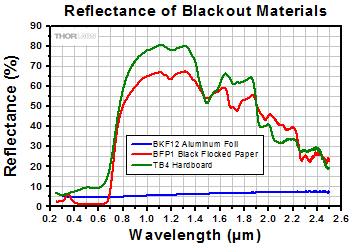
Click to Enlarge
Data Obtained at 8° AOI
Thorlabs offers a complete selection of blackout materials that are designed to control stray or ambient light, which can adversely affect experiments or components within a setup (e.g. photodetectors). These materials are especially beneficial when using high-gain detection equipment, such as in photon counting experiments, since high-gain detectors are easily saturated by room light. In ellipsometry and certain polarimetry techniques, blackout materials may be used to prevent reductions in accuracy caused by ambient light.
We offer blackout fabric, hardboard, posterboard, self-adhesive black flocked paper, aluminum foil, masking tape, and vertical blinds.
Please note that on this page, only the Laser Safety Fabric is laser safety rated. All other items on this page are not intended to be used for laser safety. For more information, please see the Laser Safety tab above.
Laser Safety and Classification
Safe practices and proper usage of safety equipment should be taken into consideration when operating lasers. The eye is susceptible to injury, even from very low levels of laser light. Thorlabs offers a range of laser safety accessories that can be used to reduce the risk of accidents or injuries. Laser emission in the visible and near infrared spectral ranges has the greatest potential for retinal injury, as the cornea and lens are transparent to those wavelengths, and the lens can focus the laser energy onto the retina.
Safe Practices and Light Safety Accessories
- Laser safety eyewear must be worn whenever working with Class 3 or 4 lasers.
- Regardless of laser class, Thorlabs recommends the use of laser safety eyewear whenever working with laser beams with non-negligible powers, since metallic tools such as screwdrivers can accidentally redirect a beam.
- Laser goggles designed for specific wavelengths should be clearly available near laser setups to protect the wearer from unintentional laser reflections.
- Goggles are marked with the wavelength range over which protection is afforded and the minimum optical density within that range.
- Laser Safety Curtains and Laser Safety Fabric shield other parts of the lab from high energy lasers.
- Blackout Materials can prevent direct or reflected light from leaving the experimental setup area.
- Thorlabs' Enclosure Systems can be used to contain optical setups to isolate or minimize laser hazards.
- A fiber-pigtailed laser should always be turned off before connecting it to or disconnecting it from another fiber, especially when the laser is at power levels above 10 mW.
- All beams should be terminated at the edge of the table, and laboratory doors should be closed whenever a laser is in use.
- Do not place laser beams at eye level.
- Carry out experiments on an optical table such that all laser beams travel horizontally.
- Remove unnecessary reflective items such as reflective jewelry (e.g., rings, watches, etc.) while working near the beam path.
- Be aware that lenses and other optical devices may reflect a portion of the incident beam from the front or rear surface.
- Operate a laser at the minimum power necessary for any operation.
- If possible, reduce the output power of a laser during alignment procedures.
- Use beam shutters and filters to reduce the beam power.
- Post appropriate warning signs or labels near laser setups or rooms.
- Use a laser sign with a lightbox if operating Class 3R or 4 lasers (i.e., lasers requiring the use of a safety interlock).
- Do not use Laser Viewing Cards in place of a proper Beam Trap.
Laser Classification
Lasers are categorized into different classes according to their ability to cause eye and other damage. The International Electrotechnical Commission (IEC) is a global organization that prepares and publishes international standards for all electrical, electronic, and related technologies. The IEC document 60825-1 outlines the safety of laser products. A description of each class of laser is given below:
| Class | Description | Warning Label |
|---|---|---|
| 1 | This class of laser is safe under all conditions of normal use, including use with optical instruments for intrabeam viewing. Lasers in this class do not emit radiation at levels that may cause injury during normal operation, and therefore the maximum permissible exposure (MPE) cannot be exceeded. Class 1 lasers can also include enclosed, high-power lasers where exposure to the radiation is not possible without opening or shutting down the laser. |  |
| 1M | Class 1M lasers are safe except when used in conjunction with optical components such as telescopes and microscopes. Lasers belonging to this class emit large-diameter or divergent beams, and the MPE cannot normally be exceeded unless focusing or imaging optics are used to narrow the beam. However, if the beam is refocused, the hazard may be increased and the class may be changed accordingly. |  |
| 2 | Class 2 lasers, which are limited to 1 mW of visible continuous-wave radiation, are safe because the blink reflex will limit the exposure in the eye to 0.25 seconds. This category only applies to visible radiation (400 - 700 nm). |  |
| 2M | Because of the blink reflex, this class of laser is classified as safe as long as the beam is not viewed through optical instruments. This laser class also applies to larger-diameter or diverging laser beams. |  |
| 3R | Class 3R lasers produce visible and invisible light that is hazardous under direct and specular-reflection viewing conditions. Eye injuries may occur if you directly view the beam, especially when using optical instruments. Lasers in this class are considered safe as long as they are handled with restricted beam viewing. The MPE can be exceeded with this class of laser; however, this presents a low risk level to injury. Visible, continuous-wave lasers in this class are limited to 5 mW of output power. |  |
| 3B | Class 3B lasers are hazardous to the eye if exposed directly. Diffuse reflections are usually not harmful, but may be when using higher-power Class 3B lasers. Safe handling of devices in this class includes wearing protective eyewear where direct viewing of the laser beam may occur. Lasers of this class must be equipped with a key switch and a safety interlock; moreover, laser safety signs should be used, such that the laser cannot be used without the safety light turning on. Laser products with power output near the upper range of Class 3B may also cause skin burns. |  |
| 4 | This class of laser may cause damage to the skin, and also to the eye, even from the viewing of diffuse reflections. These hazards may also apply to indirect or non-specular reflections of the beam, even from apparently matte surfaces. Great care must be taken when handling these lasers. They also represent a fire risk, because they may ignite combustible material. Class 4 lasers must be equipped with a key switch and a safety interlock. |  |
| All class 2 lasers (and higher) must display, in addition to the corresponding sign above, this triangular warning sign. |  |
|
| Posted Comments: | |
Mallachi Meller
(posted 2022-05-25 23:11:52.217) Hi, do you have an intention to put out the BKF12 but as foil tape? jdelia
(posted 2022-05-26 11:58:11.0) Thank you for contacting Thorlabs. We do not have any plans to do this. However, you may be interested in our T205- series aluminum foil tape which can be found under the "Black Masking Tape" section of this product page. user
(posted 2022-03-11 08:02:19.28) Hello, Do you have transmittance data for UV and VIS for the BK5 material? jdelia
(posted 2022-03-11 09:04:04.0) Thank you for contacting Thorlabs. I have reached out to you directly to share our BK5 transmission data. Andrey Kuznetsov
(posted 2022-02-15 17:37:24.063) What is the BKF12 substrate material alloy type? Is it Aluminum 1100 series or what series is it? jdelia
(posted 2022-02-16 10:18:51.0) Thank you for contacting Thorlabs. We use 1000 Series-0 Aluminum for our BKF12 foil. The alloy is most typically 1235-0 Aluminum. user
(posted 2021-08-30 17:23:46.16) What is the maximum service temperature for the BKF12 foil? azandani
(posted 2021-09-09 04:12:16.0) Hello, thank you for contacting Thorlabs. While testing at 750F under a lamp for 1 hour, we have not observed any degradation of the material. Please note this is not a formal spec so therefore we can not provide any guarantees. It is best if stored in a controlled environment (72F & 50% RH) and kept out of direct sunlight. user
(posted 2020-10-05 14:09:30.837) You guys should sell black hot glue sticks like this product (https://www.amazon.com/TOUHIA-270X11mm-Black-Melt-Sticks/dp/B07YDNWMRL) but non-fluorescent :) DJayasuriya
(posted 2020-10-06 06:57:53.0) Thank you for your feedback. We will look into this. Your local tech support team would be happy to help with any application questions that you have. Please email techsupport@thorlabs.com user
(posted 2020-02-10 15:18:24.843) Hello, how thick is the blackout material of the vertical blackout blinds? What are their transmittance in visible and UV? Thanks. YLohia
(posted 2020-03-11 05:04:15.0) Hello, thank you for contacting Thorlabs. We have measured the thickness of this material and found it to be ~0.33 mm. Unfortunately, we do not have transmittance data for these products. Sanket Shah
(posted 2019-09-26 16:19:50.703) I wanted to know the emissivity of TB4 & BFP1 in the 3 to 12 um thermal IR range. It would be great if you could provide me those details. YLohia
(posted 2019-09-30 09:31:02.0) Hello, thank you for contacting Thorlabs. Unfortunately, we do not have the transmission information of the TB4 & BFP1 materials in the 3-12 um range. p.androvitsaneas
(posted 2019-01-15 10:29:40.053) Are damage threshold data for pulsed lasers (fs, ps or ns pulsed) available for the following products:
BKF12, TB4, TB5?
Thank you. llamb
(posted 2019-01-16 08:23:51.0) Thank you for contacting Thorlabs. We do not have damage threshold data for those blackout materials. Only the LPCM1 laser safety fabric on this page is rated for laser safety. We do not recommend using other blackout materials with any pulsed or CW laser from which damage is a concern. Please see the Laser Safety tab for better laser safety alternatives. david.lang
(posted 2019-01-08 08:43:28.64) Hello,
do you have any BRDF data for the BKF12 material at around 905 nm? Thank you in advance.
Best regards
David YLohia
(posted 2019-01-09 11:08:49.0) Hello David, thank you for contacting Thorlabs. Unfortunately, we don't have BRDF data, however, we do have general reflectance data. This data was taken using an integrating sphere and therefore accounts for both specular and scattered reflections. I have reached out to you directly with the data. mledijubell
(posted 2018-12-20 04:22:57.52) Hi,
I am checking to see if custom widths are available? 17.5” (width) x 21.5” (length) would be most useful to me. Can you please provide a quote if you’re able to make a blind with this custom size?
Sincerely,
Muyinatu Bell AManickavasagam
(posted 2018-12-20 11:50:04.0) Response from Arunthathi at Thorlabs: Thanks for your query. Unfortunately, we do not offer custom sizes on the blinds (VBB060) mgarrick
(posted 2017-12-08 12:04:26.59) Hi, Can you tell me the highest temperature which the black adhesive BFP1 can withstand? Thanks in advance, Méabh nbayconich
(posted 2017-12-18 10:43:39.0) Thank you for contacting Thorlabs. The adhesive component of this paper has a storage temperature range from -65ºF to 160ºF so it is not intended to be used at temperatures beyond 160ºF. The paper material is flocked paper and is not intended for high temperatures. alexander.kuck
(posted 2017-08-31 17:13:02.37) Hi,
we are looking for a solution to black-outour lab, for biomedical imaging and microscopy. One option, is to use an already existing laser protection curtain and cover it with a black material. Would the self-adhesive paper be suitable to be applied to a curtain, without breaking or ripping?
thanks in advance,
Alex tfrisch
(posted 2017-09-01 10:20:18.0) Hello, thank you for contacting Thorlabs. The adhesive paper certainly would not slide on the track as well as our laser safety curtains, but I would not expect them to tear if they are not disturbed. I'll reach out to you directly to discuss handling. lukas.arnhold
(posted 2017-06-19 14:48:12.57) We want to use this product to shield samples. Our laser power is some mW. Do you have any reflectance data, especially under 4000 wavenumbers, to optimize the data analysis? tfrisch
(posted 2017-07-01 10:55:04.0) Hello, thank you for contacting Thorlabs. While we do not have reflection data for BKF12 below 4000 cm-1 (above 2.5um wavelength), Aluminum is very absorptive in the IR, and I would expect almost no transmission through even 50um of foil. I will reach out to you directly to discuss your application. paul.brown
(posted 2017-03-07 04:45:32.717) Hello, I am making a light box to measure reflectance of plant material. I am looking at the BK5 blackout material, how reflective is this on the non-rubber side as I'd need it to be as matt (lambertian)as possible.
Many thanks tfrisch
(posted 2017-03-13 05:49:18.0) Hello, thank you for contacting Thorlabs. While we don't have any test data on the degree to which reflections would be Lambertian, I will contact you directly to discuss our various blackout materials and what reflectance data we have collected. faceme55
(posted 2016-05-16 20:39:35.723) I make custom masks. I use fluorescence black light activated colors. My question if I put this on a stage, will then nullify anything but black light. I want to absorb the wall and other light showed to display a black light painting . besembeson
(posted 2016-05-17 09:09:32.0) Response from Bweh at Thorlabs USA: These are designed for ambient or stray light control. Black light will largely be absorbed. We have not conducted tests regarding emissions with black light. I can send you a small sample to test with. user
(posted 2015-08-03 12:36:14.983) I have a setup with a strong laser (4 W at 1064 nm) inside an enclosure; the enclosure is made of untreated aluminum which is highly reflective. To prevent possible reflections of the laser beam, I am thinking of sticking BKF12 aluminum foil to the inner walls of the enclosure. Would this pose a fire risk, i.e. could the foil be burnt by the laser? Thanks! Jerry. besembeson
(posted 2015-08-19 01:52:57.0) Response from Bweh at Thorlabs USA: We have not tested this under such conditions so we can't establish suitability at this time. peter.hansson
(posted 2014-09-05 08:51:36.89) Hi again, (noticed that the part no. was not included in my question below) According to the graph on your website, your BKF12 foil should have below 0.2 % reflectance in the visible spectrum. I find this very hard to believe. Is the specification correct? I would really apprechiate a quick answer. Best regards, Peter sharrell
(posted 2014-09-05 12:23:37.0) A Response from Sean at Thorlabs: Thank you for contacting us. I had contacted our engineering department about this, and we're currently looking into whether this data is correct. I'll update this response and e-mail you as soon as we have a definitive answer. peter.hansson
(posted 2014-09-02 17:35:15.88) Hi!
According to the graph on your website this foil should have below 0.2 % reflectance in the visible spectrum.
Just by looking at it, I find this very hard to believe. Is the specification correct?
Best regards,
Peter jgrace_3k
(posted 2014-01-27 11:10:44.28) Do you have reflectivity data on the BFP1 product? Specifically interested in the reflectivity from viz through MWIR (5 um would be nice, but any data would be useful). jlow
(posted 2014-01-27 04:13:03.0) Response from Jeremy at Thorlabs: I will contact you directly to provide a graph for the reflectivity. dmitry.s
(posted 2014-01-10 03:56:20.167) Do you have any blackout material for dark room application?
Currently we are working on our own lab facilities for imaging devices characterization so we are looking for light-absorbing materials to cover walls in the room. cdaly
(posted 2014-01-16 07:56:34.0) Response from Chris at Thorlabs: I would suggest considered the Black Flocked Self-Adhesive paper BFP1. The textured matte-black surface is the most appropriate item we offer as it is absorptive as detailed on this page. tcohen
(posted 2012-11-15 11:40:00.0) Response from Tim at Thorlabs: Our laser safety barrier is more suitable for high power (http://www.thorlabs.com/newgrouppage9.cfm?objectgroup_id=4372). Alternatively, we do have beam traps, http://www.thorlabs.com/newgrouppage9.cfm?objectgroup_id=1449, which may suit your needs. I would not recommend substituting a proper high power laser safety barrier with TB4. I see you have contacted us with further questions and we will contact you directly to discuss this further. matteo.seregni
(posted 2012-11-15 15:10:45.01) Is the TB4 hardboard compatible with high laser powers (pulsed 500W 690nm and CW 50W 532nm)? Thanks jlow
(posted 2012-11-06 15:49:00.0) Response from Jeremy at Thorlabs: We have the BK5 blackout fabric. However, it is not flame retardant. I will contact you directly to discuss about this further. gordon.noble
(posted 2012-10-26 10:27:43.777) Do you have any non-conductive blackout fabric? Ideally it needs to be fire retardant as well.
Gordon jlow
(posted 2012-10-22 17:47:49.56) Response from Jeremy at Thorlabs: We do not have the flammability rating for the TB4 black hardboard, but it should be similar to regular wood-fiber veneer. user
(posted 2012-10-16 18:25:53.633) Hi,
do you have a flammability rating for your Black hardboard, or just a general indication of flammability? Thanks tcohen
(posted 2012-09-04 12:33:00.0) Response from Tim at Thorlabs: The BK5 blackout fabric has not been tested for particulate contamination and is not rated for cleanroom applications. user
(posted 2012-08-31 09:51:38.0) Hello,
Is the BK5 rubberized fabric cleanroom compatible?
Thanks bdada
(posted 2011-10-14 12:43:00.0) Response from Buki at Thorlabs:
The black masking tapes are not classified as clean room compatible. Please contact TechSupport@thorlabs.com for further support. luis.ferreira
(posted 2011-10-13 12:22:26.0) Hello, are the black masking tapes (T137-1.0 or
T137-2.0) clean-room compatible ? Many thanks jjurado
(posted 2011-08-18 14:02:00.0) Response from Javier at Thorlabs to peter.bechtold: Thank you very much for your feedback. Since this material is made from Neoprene-coated rayon, it is as flammable as a regular fabric. We will add a note to the description of this item to emphasize this. We will also look into offering blackout material made from special grade flame retardant fabric. peter.bechtold
(posted 2011-08-17 17:10:06.0) PLEASE do add a remark to the description that this material is highly flammable! I would have never thought so (it is no laser curtain - yes - but as a laser accessory seller I would never think that Thorlabs sells easily flammable material!).
It would be good imho if you add a product which is basically the same but just not flammable.
Best,
Peter Adam
(posted 2010-05-03 09:11:40.0) A response from Adam at Thorlabs: The BK5 should be free of pinholes. If you need to block bright sunlight we would recommend a double layer since a double layer will give you greater blocking efficiency. dave
(posted 2010-05-03 04:21:44.0) hi.
is the bk5 material free of pinholes? would a double/triple layer be sufficient to block bright sunlight (camera bellows)?
kind regards,
dave klee
(posted 2009-10-23 16:21:45.0) A response from Ken at Thorlabs to fschewe: The exact dimensions are 24" x 24", which translate to 609.6 mm x 609.6 mm. The metric dimensions on page 396 are rounded. fschewe
(posted 2009-10-23 14:28:40.0) Short remark: In the catalog on page 194 the size of the black-out material is given by 609.9 mm x 609.9 mm. On page 396 it is 610 mm x 610 mm. And on page 1236 again 609.9 mm x 609.9 mm. |

- Polyurethane Coating on Weaved Nylon Fabric
- Double-Layered Use is Recommended for Extremely Sensitive Applications
- Available from Stock in 5' x 9' Sheets (W x L)
- Custom Lengths Available by Contacting Tech Support
- Not Intended for Use in Laser Safety Applications
This black, polyurethane-coated nylon fabric provides an easy method for protecting light-sensitive equipment, as the polyurethane coating prevents light from penetrating through the weave of the nylon. Double-layer use is recommended for extremely sensitive applications. Please note that this material is not intended for use as a laser curtain since it is not flame retardant. The fabric has also not been tested for clean room compatibility.
We can cut this material into custom lengths (in yards) that fit your application. Please contact Tech Support for a quote.

- Blocks Stray or Unwanted Light
- Easily Shaped with Scissors or a Utility Knife
- 1/16" (1.6 mm) Thick, Solid Cardboard Panel
- Not Intended for Use in Laser Safety Applications
Thorlabs' black panels are an essential component of light-tight enclosures. Our TB5 Black Posterboard is 1/16" (1.6 mm) thick and ships in packages of five 20" x 30" (50.8 cm x 76.2 cm) panels. Simply score the panel with a utility knife and bend to form a light-tight corner. We recommend using our 2" wide black masking tape for other joints to eliminate the passage of light through those areas.

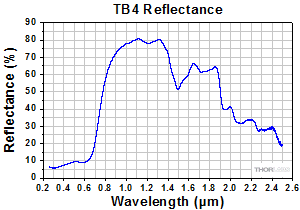
Click to Enlarge
The data was obtained at an 8° AOI. Please note that the curve above shows reflectance of the TB4 hardboard, not the TB5 posterboard.
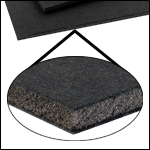
Click to Enlarge
Close-Up of TB4
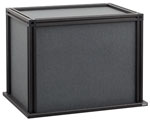
Click to Enlarge
Enclosure with TB4 Panels
- Blocks Stray or Unwanted Light
- Easily Shaped with a Utility Knife
- 3/16" Thick, Plastic-Coated Cardboard Panel with Foam Core
- Not Intended for Use in Laser Safety Applications
Thorlabs' TB4 Black Hardboard is 3/16" (4.76 mm) thick and ships in packages of three 24" x 24" (61.0 cm x 61.0 cm) panels. Compared to TB5 above, the increased thickness provides enhanced acoustic absorption, while the foam core (pictured to the right) helps it remain lightweight. We recommend using our 2" wide black masking tape for corners and other joints to eliminate the passage of light through those areas. This is the same hardboard used in our preconfigured optical enclosures.
Upon request, we can offer the TB4 hardboard in custom sizes from 2" x 2" (5.1 cm x 5.1 cm) up to 48" x 48" (121.9 cm x 121.9 cm) to customers in North America, or up to 44" x 32" (111.8 cm x 81.3 cm) elsewhere. Please contact Tech Support for a quote.

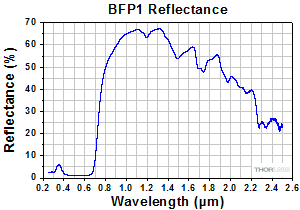
Click to Enlarge
Data Obtained at 8° AOI
- Self-Adhesive
- Does Not Shed Dust or Lint
- 30" x 30" x 0.012" (76.2 cm x 76.2 cm x 0.305 mm) Without Backing
- Not Intended for Use in Laser Safety Applications
Flocked paper is a self-adhesive material made of many fine fibers. It has a textured, matte-black surface. When viewed at from low angles, it absorbs virtually 100% of the visible light that strikes it. The fibers will not shed dust or lint, unlike some velvet and felt materials. The approximate compressed thickness of the flocked paper is 0.015" (0.381 mm) with the backing and 0.012" (0.305 mm) without the backing.
Image contrast can suffer due to stray light reaching the focal plane of many applications where the light path travels through a tube or other enclosed area. Applying a flat-black paint to the inside may help, but a textured matte-black surface is a much more effective light trap.
Caution: Do not cut the BFP1 black flocked paper with a laser cutting tool, as the BFP1 burns easily and may catch fire. It is suggested that you use a utility knife or other sharp edged tool to cut the BFP1.

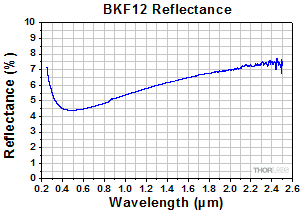
Click to Enlarge
Data Obtained at 8° AOI
- Ideal for Masking Light Leaks and Eliminating Unwanted Reflections
- Highly Flexible, Lightweight, and Corrosion Resistant
- Use with a Wide Range of Radiation Sources (Including X-Ray and UV)
- Not Intended for Use in Laser Safety Applications
This durable, lightweight foil has a matte black finish to absorb light from any ambient or conventional light source. It can be molded quickly to form blackout covers, dark rooms, laser channels, or other configurations so as to mask light leaks or eliminate unwanted reflections. Secure its position using tape, staples, or adhesives. This black aluminum foil is sold on a roll and measures 1' x 50' (305 mm x 15.2 m).

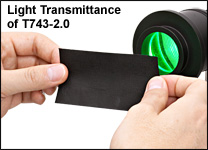
Click to Enlarge
High-Performance Black Masking Tape
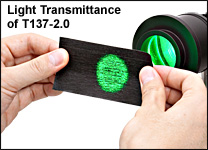
Click to Enlarge
Black Masking Tape
- 1" (25 mm) and 2" (50 mm) Wide Versions Available
- Paper-Based Masking Tape for General Purpose or Blackout Applications
- Aluminum Foil Tape for Total Blackout Applications
- Can be Torn by Hand and Removed Easily Without Leaving Residue
- Not Intended for Use in Laser Safety Applications
Thorlabs offers a standard and high-performance black masking tape, as well as an aluminum foil masking tape. All types of tape can be torn by hand, are easy to remove, and do not leave a residue. The T137-1.0 and T137-2.0 black masking tape can be used for general applications. For applications requiring minimal ambient light transmission, the T743-1.0 or T743-2.0 high-performance black masking tape is recommended. For total blackout requirements or high-power applications, we offer the T205-1.0 or T205-2.0 non-reflective, flame-retardant aluminum tape. This foil tape has been tested to withstand up to 10 seconds of exposure from a 20 W, Ø6 mm, 10.6 µm laser beam.
In the photographs shown above, a collimated LED (Item # M530L2-C2) with approximately 170 mW output power was used to illustrate how the T743-2.0 high-performance tape allows very little light transmission as compared to the T137-2.0 standard black masking tape. The table below gives the measured power and percent transmittance when various wavelengths of light were incident upon each type of tape.
| Black Tape Performance | |||
|---|---|---|---|
| Incident Power | Measured Output Power (% Transmittance) | ||
| T137-2.0 Masking Tape | T743-2.0 High-Performance Masking Tape | T205-2.0 Aluminum Foil Tape | |
| 1.07 mW at 635 nm | 1.34 µW (0.13%) | 0.90 µW (0.08%) | Zero (0%) |
| 4.79 mW at 635 nm | 5.92 µW (0.12%) | 0.24 µW (<0.01%) | Zero (0%) |
| 1.41 mW at 632.991a | 3.36 µW (0.24%) | 0.012 µW (<0.01%) | Zero (0%) |
| 20.34 mW at 850 nmb | 28.74 µW (0.14%) | 1.04 µW (<0.01%) | 0.0006 µW (<1 x 10-5%) |

| Laser Safety Fabric Certifications | |
|---|---|
| Wavelength | Certificationa |
| D AB10 I AB5 R AB4 M AB4 |
|
| D AB7 | |
| R AB6 I AB8 M AB8 |
|
| D AB5 | |
| D AB4 I AB5 R AB2 |
|

Click to Enlarge
A laser safety label is attached to the rolls of fabric with 1.0 m and 3.05 m lengths.
- Laser Rated Fabric Certified to EN 12254: 2010(E)
- 1.6 m Wide Fabric in 1.0 m, 3.05 m, and 10.0 m Lengths
- 1.65 mm Thick
- Can Be Easily Cut into Custom Sizes
- Flame Retardant
- Custom Lengths Available by Contacting Tech Support
Thorlabs' laser safety fabric is designed to withstand high laser energy up to EN 12254: 2010(E) certification with the flexibility to be cut into custom sizes to suit experimental needs. The laser rated material is made of a rubber compound fabric, which is the same material used to make our laser safety curtain panels. The table to the right gives the certifications applicable for certain wavelength regions; to see the complete EN 12254: 2010(E) certification, please click here. The customizable nature of this fabric makes it ideal for creating window covers and building custom enclosures for experiments and optical systems. Please ensure that the cutting tool you are using is sharp in order to reduce frayed edges. A red laser safety label, as seen in the image to the right, is attached to each sheet of 1.0 m and 3.05 m long fabric.
Some material may need to be trimmed off either end of the LPCM10 prior to use. However, a minimum of 10.0 m of usable material is included. Please note that the LPCM10 is shipped in a crate weighing over 60 kg (132 lbs) and requires a forklift for transport. The roll itself is approximately 30 kg (66 lbs); a team lift is recommended.
*DISCLAIMER
This laser safety fabric has been tested by a third party using EN specifications; to see the complete certification details, please click here. Due to manufacturing variances, mechanical wear, and laser damage, Thorlabs assumes no responsibility for laser material failure. Please consult your local laser safety specialist before purchasing to ensure that the fabric is suitable for your application. To minimize risk, inspect the material before each use and ensure that it is in excellent condition.

- Blackout Material
- 1.7 m (66.9") Drop
- Choice of Four Widths: 600 mm (23.6"), 900 mm (35.4"), 1200 mm (47.2"), or 1500 mm (59.1")
- Can Be Fitted Inside or Outside the Window Recess
- Conventional Roller Blind Chain Operating System
- Not Intended for Use in Laser Safety Applications
These blackout blinds are made from a black, rubberized fabric. Designed for applications where light exclusion is required, such as laboratories and dark rooms, they can be used to keep stray light out of photosensitive setups. They are also useful for preventing bright sources from being visible by people outside the lab. The fabric is totally opaque, and the blinds are manually operated by a side chain. They can be attached to the wall or window recess using the two brackets and four screws that are supplied. Please note that the blinds are not intended for use as a laser curtain since the material is not flame retardant. The material has also not been tested for cleanroom compatibility.
 Products Home
Products Home









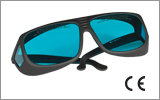
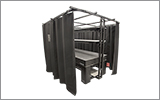
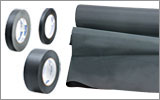
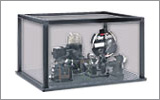
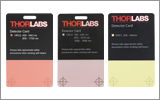
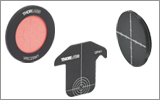
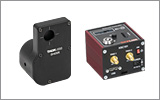
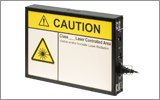
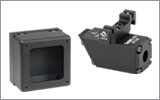
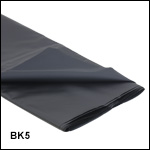
 Zoom
Zoom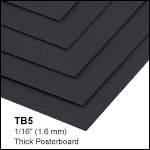
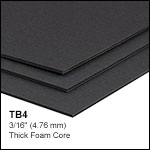
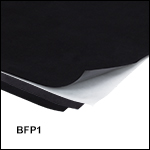
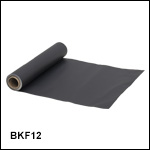
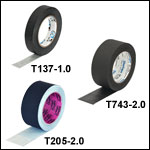
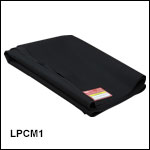
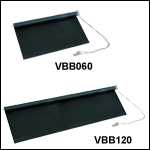
 Blackout Materials
Blackout Materials